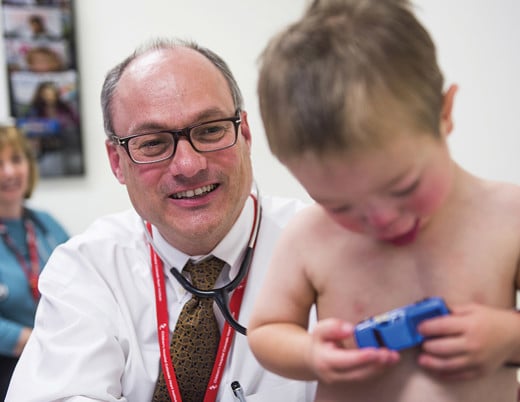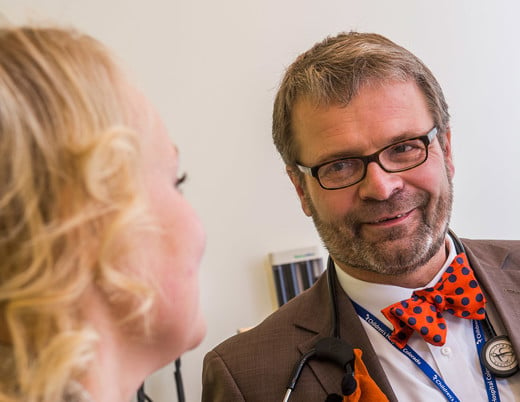How does a new medical device enhance the quality of life for young patients facing severe cardiac conditions?
In the evolving landscape of pediatric cardiology, Dustin “Dusty” Nash, MD, of Children’s Hospital Colorado, successfully performed the first implantation of an extravascular implantable cardioverter defibrillator, or EV-ICD, at a pediatric center. This minimally invasive ICD system marks a significant leap in medical technology and signals a paradigm shift in treating young patients with life-threatening cardiac conditions. Jordan, an 18-year-old competitive runner diagnosed with long QT syndrome, emerged as the ideal candidate for this first-of-its-kind procedure.
Unlike traditional ICDs that are implanted below the collarbone with the leads threaded through the veins and into the heart, the EV-ICD system is implanted below the left armpit (in the left midaxillary region) with the lead placed under the sternum. This placement helps avoid certain complications associated with transvenous leads, such as vascular injury and vessel occlusion. Dr. Nash’s selection of the EV-ICD for Jordan was guided by a comprehensive evaluation of its benefits over traditional ICDs. The device’s minimal invasiveness and the promise of a quicker recovery period were key factors in the decision.
“Jordan was quite a competitive cross country and track and field runner, so the EV-ICD felt like a good fit because it doesn’t carry the same amount of exercise restrictions after implantation,” Dr. Nash says.
Jordan’s active engagement in competitive running and his recent diagnosis of long QT syndrome, which could potentially trigger a dangerous heart rhythm, necessitated a solution that could address the medical need without significantly hindering his physical activity. The EV-ICD emerged as the most suitable option, promising to mitigate the risk of sudden cardiac events while accommodating his athletic pursuits.
“The device not only protected Jordan against potential cardiac incidents but also empowered him to reclaim control over his life, providing an overall sense of normalcy amid the challenges posed by his condition.”
- Dustin “Dusty” Nash, MD
EV-ICD preparation and execution
The implantation preparation for the EV-ICD involved intensive training and planning, highlighting the meticulous approach required for such a novel procedure. Dr. Nash and colleagues underwent specialized training, including practice with animal models and cadavers, to master the device’s technical and procedural nuances.
“Collaboration with Medtronic, the developer of the device, was crucial, providing essential support and expertise for a successful implantation,” Dr. Nash says. “They really walked us through the nitty-gritty, the nuts and bolts of how to do this successfully.”
Redefining cardiac recovery
Jordan’s postoperative recovery not only underscored the EV- ICD’s significant advantages in reducing downtime but also highlighted the device’s role in enhancing quality of life for patients with serious cardiac conditions. Jordan was able to resume light exercise within two weeks post-procedure, and his experience exemplified the device’s beneficial impact on recovery timelines — a stark contrast to the lengthy and often restrictive recovery periods mandated by traditional ICDs. This expedited rehabilitation process allowed for a swift reintroduction to daily routines and activities, markedly diminishing the psychosocial and physical repercussions commonly experienced during prolonged recoveries. Furthermore, Jordan’s ability to rapidly engage in physical activity without the fear of compromising his recovery or triggering adverse events demonstrated the EV-ICD’s superior safety and efficacy profile.
“The device not only protected Jordan against potential cardiac incidents but also empowered him to reclaim control over his life, providing an overall sense of normalcy amid the challenges posed by his condition,” Dr. Nash says.
The future of pediatric cardiac care
Dr. Nash’s successful EV-ICD implantation not only establishes a new benchmark in pediatric cardiac care but also opens the door to its potential application in younger patients, thereby expanding the horizons of treatment possibilities within pediatric cardiology. The innovative use of 3D modeling in evaluating the suitability of EV-ICDs for various age groups demonstrates a forward-thinking approach to personalized medicine, tailoring interventions to meet the specific anatomical and physiological needs of each patient.
“We’re not planning on jumping right into implantation for a 6-year-old, but with 3D modeling we’re starting to ask whether EV-ICDs are appropriate for 16-year-olds, 14-year-olds and so on,” Dr. Nash says.
This cautious yet progressive strategy reflects a deep commitment to patient safety and the optimization of outcomes. By gradually extending the age range for potential candidates, the team is methodically assessing the risks and benefits, ensuring that the device’s application is both scientifically sound and clinically advantageous.
Moreover, Dr. Nash’s work signifies a crucial step toward inclusivity in treatment options for pediatric patients facing cardiac challenges. Exploring the use of EV-ICDs for younger demographics highlights the ongoing efforts to fill the gap in available cardiac interventions for children, who often face limited options due to their unique anatomical and developmental considerations. It underscores the importance of innovation in pediatric healthcare, pushing the boundaries of what’s possible to enhance the lives of children with cardiac conditions.
Featured researcher

Dustin "Dusty" Nash, MD
Cardiologist
The Heart Institute
Children's Hospital Colorado
Assistant professor
Pediatrics-Cardiology
University of Colorado School of Medicine





 720-777-0123
720-777-0123










